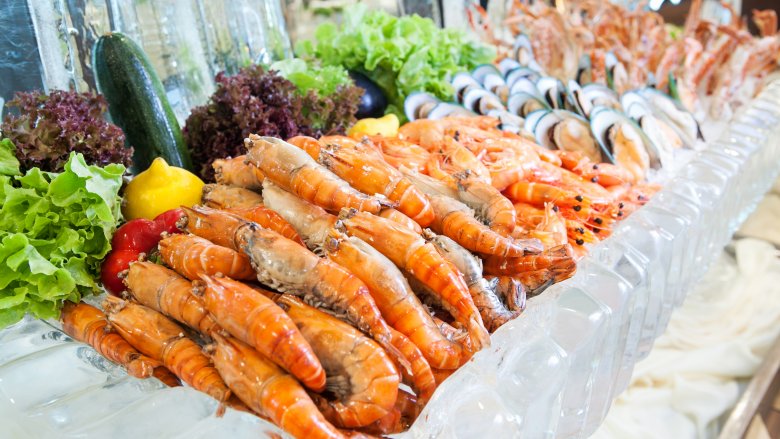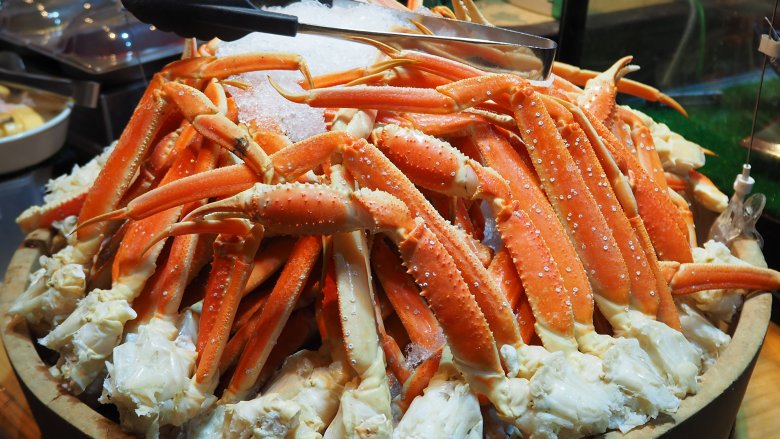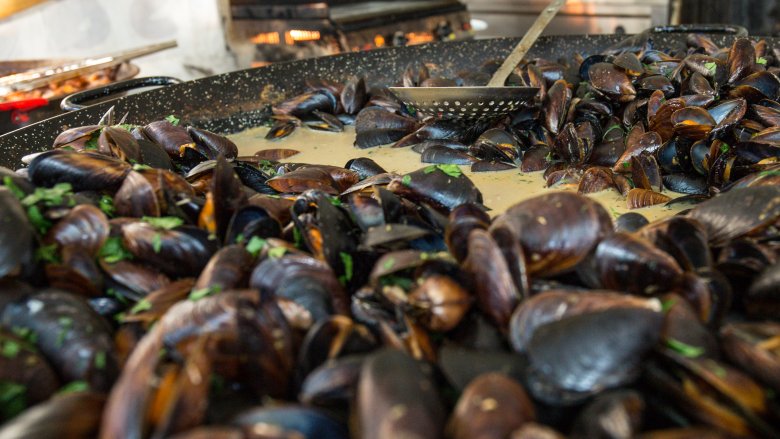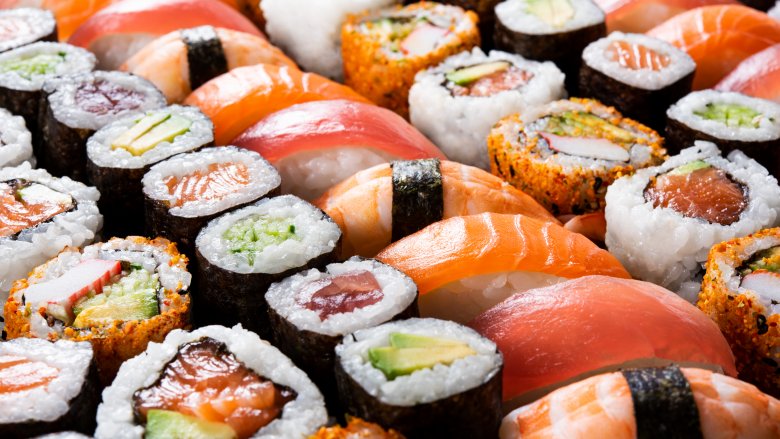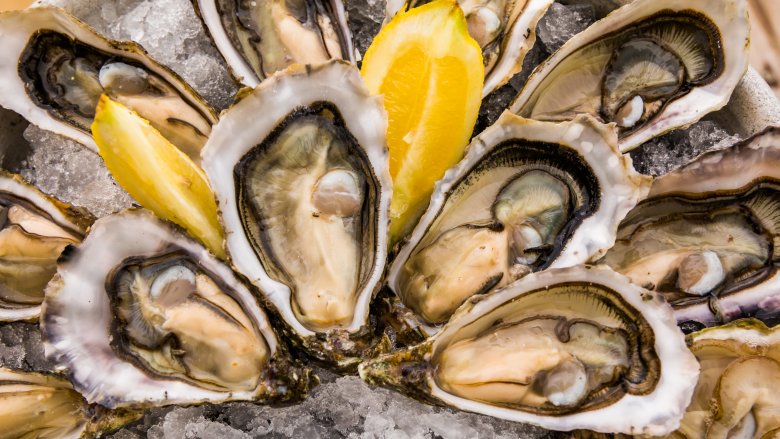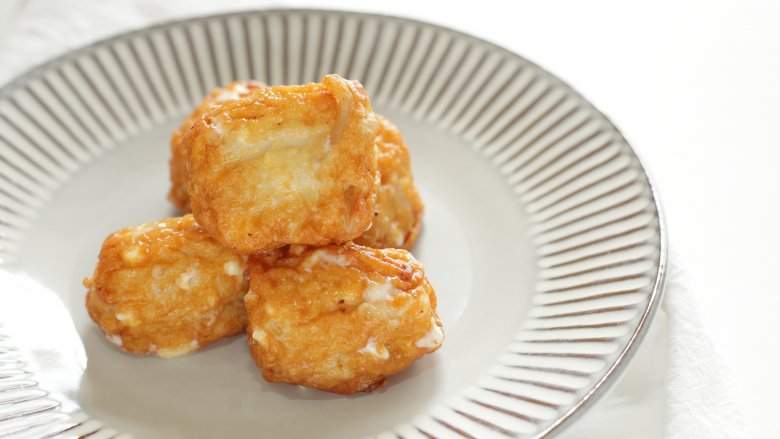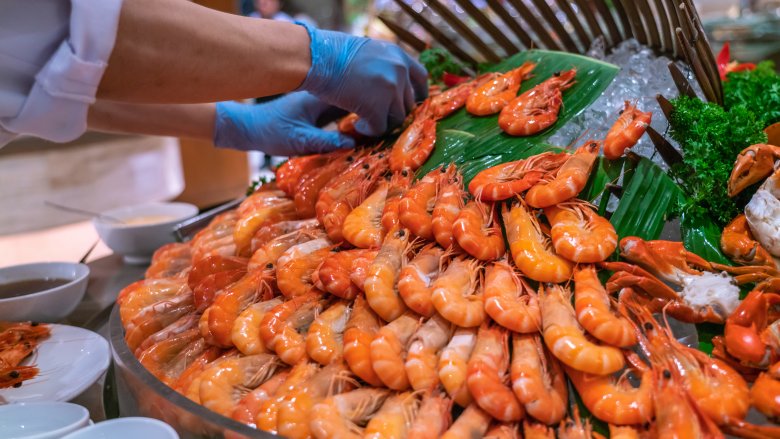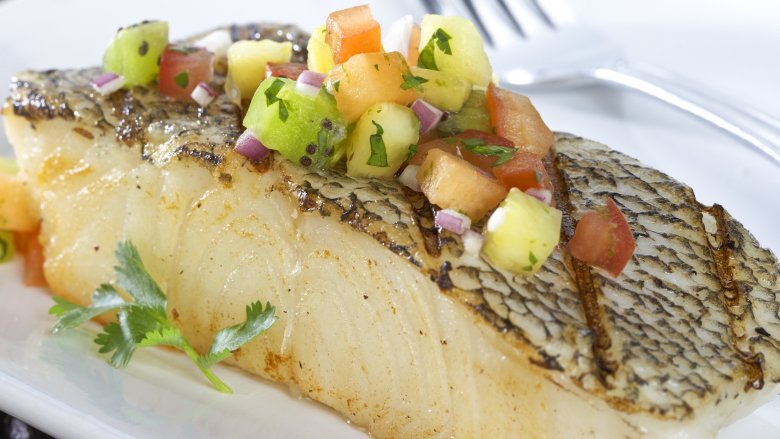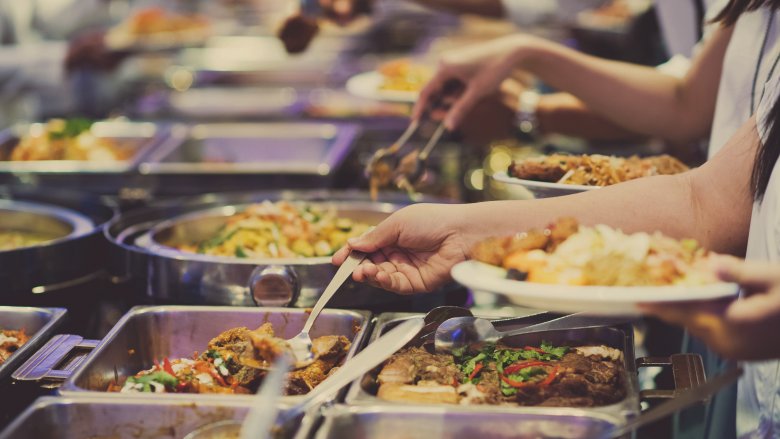The Truth About All-You-Can-Eat Seafood Buffets
Buffets have quite an international history. Their origins are in Sweden and France, but the man who created the first American all-you-can-eat buffet was actually Canadian. Lucky for us, he moved to Vegas and started the Buckaroo Buffet at the hotel where he worked at the time, El Rancho Vegas. Since consuming massive amounts of calories is indeed the American way, it's not surprising the buffet restaurant concept thrived and branched off into specialties like Chinese, Indian and seafood.
While a lot of folks might reserve their seafood consumption for when they're in a coastal area, there are plenty of people who have no problem with a seafood smorgasbord in the middle of America, especially considering how easy it is to quickly ship food from all over the world now. But what are some underground facts about seafood buffets that Americans might not be willing to accept? Here is the ultimate insider lowdown on your favorite vacay or post-church feast. This is the untold truth of seafood buffets.
The crab legs are hassle — and they might get you beat up
For both practical and health reasons, you might want to skip the crab legs in the buffet line. According to a Reddit user who claims to have managed a casino buffet, the buffet crab legs are not worth the mess you create (and the time you waste) while eating them.
Also, wait for the fresh crab legs to come out of the kitchen at your own risk — they may not be worth it. A couple of customers at a Huntsville, Alabama buffet got into a full blown buffet fight over who was first in line for the fresh batch of crab legs en route to the buffet. We get that they're good, but willing-to-risk-a-broken-nose good? Maybe stick to the tray of fried crab claws instead.
Another alleged all-you-can-eat buffet operator also claimed in a Reddit thread that crab legs at a buffet often aren't chosen or prepared properly. He claims to have regularly witnessed buffet employees "at the fish market going and buying bottom of the barrel seafood including crab legs past their prime. And then they don't steam them properly either to save on volume." The owner also said in the same Reddit thread that his buffet wouldn't even think about serving cheap crab legs because of the legal ramifications if someone gets sick — though he doesn't seem to believe everyone follows those rules.
You should probably steer clear of mussels
Anthony Bourdain famously wrote in his 2000 restaurant expose Kitchen Confidential (via INSIDER) that he only eats mussels at restaurants if he personally knows the chef. The risk of sickness from eating a mussel that isn't prepared correctly is just too high. Boston chef and restaurant owner Mary Dumont agrees, telling INSIDER, "I never order mussels at restaurants...I'm meticulous about their storage and care if I serve them, but all it takes is one bad mussel and you're down for the count."
So since mussels are a bit of a specialty item, it seems like they might be best consumed when prepared by chefs who more than likely aren't working at all-you-can-eat seafood buffets. There is definitely no guarantee that the mussels are being prepared properly from water to table, which is really important with this mollusk. In fact, mussels are so delicate that they should be served within two to three days of being caught, if they're fresh. Not to mention, a food reporter from Houston Press once described the mussels he at at a seafood buffet as "Dr. Scholl's inserts dipped in chlorine."
Mussels are a delicacy perhaps best served at only the highest level dining establishments.
Eating the sushi is risky
It could be the fanciest sushi restaurant on the planet, and you'd still need to think twice before shoveling that spicy tuna roll down your gullet. It is raw fish, after all. When it comes to sushi, good quality and precise preparation are essential. If it's not kept at the right temperature, it can make you really sick, really quick. This is why it's probably advisable to avoid the sushi at your next seafood buffet jaunt.
There is no guarantee, even if the sushi is prepared by an expert sushi chef behind the scenes at your local seafood buffet, that the other buffet employees are keeping track of how long it's been sitting out and if it's at ideal temperatures for sushi. If they don't keep the sushi on ice, the amount of bacteria can rapidly expand in under 60 minutes. If you're gonna go raw or go home, home is definitely preferable to going raw at an all-you-can-eat seafood buffet.
Seafood buffet raw oysters could be a mistake, too
Eating raw oysters is dicey no matter where you do it — and no matter how delicious they taste. Oysters are filter feeders and can contain viruses and bacteria that can cause disease when served raw, and the scary part is, there's no way to tell just by tasting them. Commercially harvested oysters do have processing steps by which the bacteria is usually eliminated, but experts still warn that raw oyster lovers should slurp at their own risk. The known risk for consuming raw oysters is perhaps why consumers are warned to carefully consider hitting the raw bar at a seafood buffet. WebMd reports that you straight up should not consume oysters at a buffet, claiming they've likely got "seawater pathogens." Doesn't that sound delicious?
An all-you-can-eat buffet owner took to Reddit to basically reiterate the overall recommendation that buffet oysters should be a no-go for your plate, especially if the buffet is located inland. The user says, "Oysters are also to be avoided as they source them, especially in the Midwest, from groceries and fisheries past their prime. Sometimes on the coasts they are imported from China and South America, but are decent quality while they are fresh." Seems like no matter how you spin it, raw foods and seafood buffets just don't mix.
If it's covered in cheese, it's probably not very fresh
It's pretty common knowledge that Italian culinary experts, and subsequently some American ones, say that seafood and cheese are not BFFs. While there are exceptions, people usually don't mess with a combo of cheese and fish. Some foodies claim the flavors of seafood and the flavors of cheese are respectively too delicate and too strong to pair well. In fact, cheese usually masks the seafood flavor (you win, cheese). Although, lobster mac 'n cheese and creamy crab dip enthusiasts and might take issue with this.
What's this got to do with seafood buffets? Well, there is a slight chance that if a buffet is serving a seafood dish that's smothered in a cheesy sauce, or cheese of any kind, they might be trying to hide something. In fact, a Reddit member claiming to be a buffet operator insists expired seafood is the real reason behind that cheese-laden sauce. The user said, "If it is seafood covered in cheese, they are covering its expiration." This is, of course, just a theory among those who detest the combo of cheese with seafood. It just might be wise to consider the context of the diary in the seafood buffet dish. Is all that cheesy glory really worth the risk? That's for you to decide.
The shrimp is probably not local (not even close)
It's no secret, Americans love their foreign-born seafood. In fact, 90 percent of the seafood we consume was imported from other countries (usually in southeast Asia and Central America). In 2017, we imported more than six billion pounds of seafood. And shrimp appears to be a stand-out American fave. According to NOAA Fisheries, it's the most popular of all the underwater fare we import. Apparently our most reliable shrimp hookup is India. As of February 2019, India was the number one shrimp importer to the U.S. for the fourth year in a row, beating Thailand, Ecuador, and Indonesia. From Southeast Asia to the buffet line on the Vegas strip is a long journey, but it's reported that 32 percent of our shrimp comes from India.
While there is always a chance that coastal or high end buffets got their shrimp from a local America fishmonger, it's highly unlikely. So why does that matter? There are some risks associated with imported shrimp. The shrimp farms from Southeastern Asia do result in negative environmental consequences in the area and carry a risk for antibiotic contamination. And Thailand shrimp facilities have been linked to human trafficking.
If eating locally sourced seafood is important to you, you might have to do a little legwork to get it. And since eating only local shrimp means eating it seasonally and paying a higher price, it's probably not what you'll find at seafood buffets.
'Chilean Sea Bass' is a made-up name
If your favorite seafood buffet has Chilean Sea Bass on the line, congrats, that's one fancy buffet. Chilean Sea Bass is usually associated with fine dining, but that hasn't always been the case. The fish we know as the Chilean Sea Bass used to be called the Patagonian or Antarctic toothfish. Legend has it in the 1970s American fish merchant, Lee Lantz, stumbled upon the five-foot long fish near a Chilean port. He decided the fish was just bland enough to be a great "blank canvas" for American chefs. Not knowing its real name, locals had referred to fish as "cod of the deep," but Lantz figured bass was a more familiar term for the American palate. So he started marketing and selling the toothfish as the Chilean Sea Bass. Then, in 1980, a company that had been using halibut to make fish sticks, snapped up the Chilean Sea Bass inventory from Lantz.
After that, the fish started making headway with Chinese restaurants (who bought it as a cheap alternative to black cod) and ultimately A-list chefs, who thought it was super versatile when it came to flavoring (as Lantz smartly predicted). It became so popular that a "Take a Pass on Chilean Sea Bass" campaign started to encourage cutting back on the overfished seafood chef hit. Still, people continue to pay top dollar for fish that at one point was in stick form in the frozen food aisle. Seafood buffets serving Chilean Sea Bass usually have a pricey entry fee but just know that you're paying that price for a toothfish.
It might not be the fish that makes you sick
According to the Centers for Disease Control and Prevention (via Food Safety News), one of the primary ways a buffet might make you sick isn't the food, but what's serving it. As opposed to a high school cafeteria, for example, there isn't a worker doling out the food in a buffet line to make sure the handle doesn't drop in the platter of popcorn shrimp, or that someone who hasn't washed their hands can't grab it. The sneeze guard helps somewhat with contamination of the food but there isn't a lot of regulation on what's happening with that big spoon hungry diners are using to heap that shrimp 'n grits onto their plates.
Disease prevention experts emphasize that picking up that serving utensil is basically the equivalent of shaking hands with everyone at the buffet that day — and then sitting down to a meal. You might want to use a napkin to pick up the serving utensil, and definitely let an employee know if the handle of the ladle has dropped into the lobster bisque. Or maybe just skip the buffet.
Pregnant women should probably skip them
It's been established that buffets are virtual petri dishes of viruses and bacteria, which is why some people have an even greater risk than others. Allison Agwu, a professor from Johns Hopkins School of Medicine whose expertise is in pediatric and adult infectious diseases told a reporter from Tonic, "Particular people such as pregnant women, babies, and people whose immune systems are not normal can possibly get these viruses and bacteria from buffets and be violently ill."
Pregnant women already have to be careful with their diet without having to factor in the free-for-all buffet risks. There are also certain seafoods in particular that experts warn pregnant women to avoid, which might be tricky at a buffet if items aren't labeled properly. For those that are super susceptible, the risk for illness might not be worth the endless shrimp cocktail.
